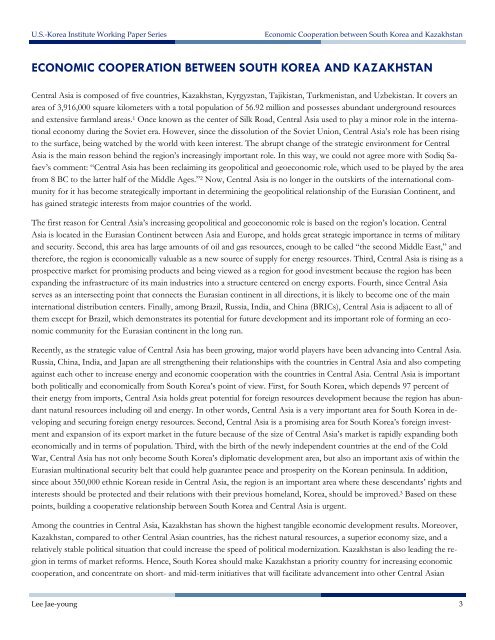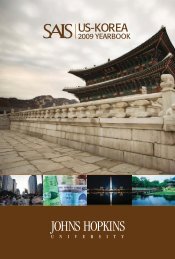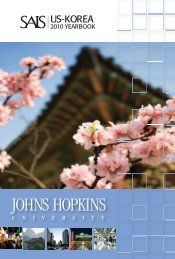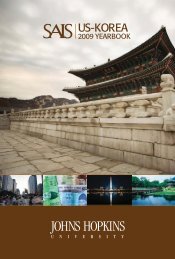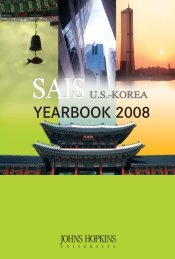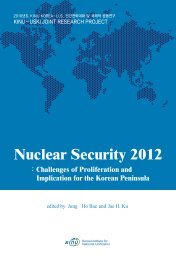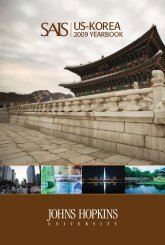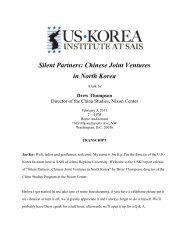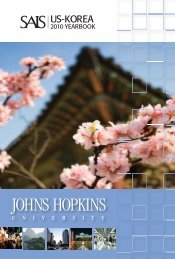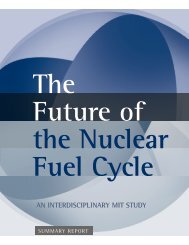Economic Cooperation between South Korea and Kazakhstan
Economic Cooperation between South Korea and Kazakhstan
Economic Cooperation between South Korea and Kazakhstan
You also want an ePaper? Increase the reach of your titles
YUMPU automatically turns print PDFs into web optimized ePapers that Google loves.
U.S.‐<strong>Korea</strong> Institute Working Paper Series<strong>Economic</strong> <strong>Cooperation</strong> <strong>between</strong> <strong>South</strong> <strong>Korea</strong> <strong>and</strong> <strong>Kazakhstan</strong>ECONOMIC COOPERATION BETWEEN SOUTH KOREA AND KAZAKHSTANCentral Asia is composed of five countries, <strong>Kazakhstan</strong>, Kyrgyzstan, Tajikistan, Turkmenistan, <strong>and</strong> Uzbekistan. It covers anarea of 3,916,000 square kilometers with a total population of 56.92 million <strong>and</strong> possesses abundant underground resources<strong>and</strong> extensive farml<strong>and</strong> areas. 1 Once known as the center of Silk Road, Central Asia used to play a minor role in the internationaleconomy during the Soviet era. However, since the dissolution of the Soviet Union, Central Asia’s role has been risingto the surface, being watched by the world with keen interest. The abrupt change of the strategic environment for CentralAsia is the main reason behind the region’s increasingly important role. In this way, we could not agree more with Sodiq Safaev’scomment: “Central Asia has been reclaiming its geopolitical <strong>and</strong> geoeconomic role, which used to be played by the areafrom 8 BC to the latter half of the Middle Ages.” 2 Now, Central Asia is no longer in the outskirts of the international communityfor it has become strategically important in determining the geopolitical relationship of the Eurasian Continent, <strong>and</strong>has gained strategic interests from major countries of the world.The first reason for Central Asia’s increasing geopolitical <strong>and</strong> geoeconomic role is based on the region’s location. CentralAsia is located in the Eurasian Continent <strong>between</strong> Asia <strong>and</strong> Europe, <strong>and</strong> holds great strategic importance in terms of military<strong>and</strong> security. Second, this area has large amounts of oil <strong>and</strong> gas resources, enough to be called “the second Middle East,” <strong>and</strong>therefore, the region is economically valuable as a new source of supply for energy resources. Third, Central Asia is rising as aprospective market for promising products <strong>and</strong> being viewed as a region for good investment because the region has beenexp<strong>and</strong>ing the infrastructure of its main industries into a structure centered on energy exports. Fourth, since Central Asiaserves as an intersecting point that connects the Eurasian continent in all directions, it is likely to become one of the maininternational distribution centers. Finally, among Brazil, Russia, India, <strong>and</strong> China (BRICs), Central Asia is adjacent to all ofthem except for Brazil, which demonstrates its potential for future development <strong>and</strong> its important role of forming an economiccommunity for the Eurasian continent in the long run.Recently, as the strategic value of Central Asia has been growing, major world players have been advancing into Central Asia.Russia, China, India, <strong>and</strong> Japan are all strengthening their relationships with the countries in Central Asia <strong>and</strong> also competingagainst each other to increase energy <strong>and</strong> economic cooperation with the countries in Central Asia. Central Asia is importantboth politically <strong>and</strong> economically from <strong>South</strong> <strong>Korea</strong>’s point of view. First, for <strong>South</strong> <strong>Korea</strong>, which depends 97 percent oftheir energy from imports, Central Asia holds great potential for foreign resources development because the region has abundantnatural resources including oil <strong>and</strong> energy. In other words, Central Asia is a very important area for <strong>South</strong> <strong>Korea</strong> in developing<strong>and</strong> securing foreign energy resources. Second, Central Asia is a promising area for <strong>South</strong> <strong>Korea</strong>’s foreign investment<strong>and</strong> expansion of its export market in the future because of the size of Central Asia’s market is rapidly exp<strong>and</strong>ing botheconomically <strong>and</strong> in terms of population. Third, with the birth of the newly independent countries at the end of the ColdWar, Central Asia has not only become <strong>South</strong> <strong>Korea</strong>’s diplomatic development area, but also an important axis of within theEurasian multinational security belt that could help guarantee peace <strong>and</strong> prosperity on the <strong>Korea</strong>n peninsula. In addition,since about 350,000 ethnic <strong>Korea</strong>n reside in Central Asia, the region is an important area where these descendants’ rights <strong>and</strong>interests should be protected <strong>and</strong> their relations with their previous homel<strong>and</strong>, <strong>Korea</strong>, should be improved. 3 Based on thesepoints, building a cooperative relationship <strong>between</strong> <strong>South</strong> <strong>Korea</strong> <strong>and</strong> Central Asia is urgent.Among the countries in Central Asia, <strong>Kazakhstan</strong> has shown the highest tangible economic development results. Moreover,<strong>Kazakhstan</strong>, compared to other Central Asian countries, has the richest natural resources, a superior economy size, <strong>and</strong> arelatively stable political situation that could increase the speed of political modernization. <strong>Kazakhstan</strong> is also leading the regionin terms of market reforms. Hence, <strong>South</strong> <strong>Korea</strong> should make <strong>Kazakhstan</strong> a priority country for increasing economiccooperation, <strong>and</strong> concentrate on short- <strong>and</strong> mid-term initiatives that will facilitate advancement into other Central AsianLee Jae‐young 3


